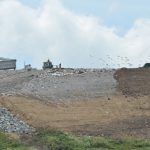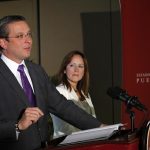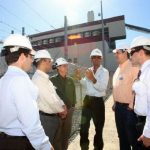Toxic Ash: A Caribbean time bomb Part 3 – Puerto Rico and EPA amend AES contract behind closed doors
 By Omar Alfonso From CARIBBEAN360
By Omar Alfonso From CARIBBEAN360
This is the final part of a three-part investigative series produced by Puerto Rico’s Center for Investigative Journalism, in collaboration with La Perla del Sur newspaper, about the environmental and health threat posed by coal ash in Puerto Rico and the Dominican Republic.
On a summer day in 2015, the elevator doors at the headquarters of the Puerto Rico Electric and Power Authority (PREPA) in Santurce opened.
Off the elevator walked out Manuel Mata, President of AES Puerto Rico, a company that since 2002 has sold 454 megawatts of electricity to the public corporation derived from its coal fuel plant in Guayama. The annual invoice for the deal exceeds US$300 million.
Without attracting attention and protected from public scrutiny, Mata walked up to the executive offices and signed a legal document. It dealt with an amendment in the contract made between the multinational company and PREPA: a clause that prohibited the company from disposing its waste derived from the burning of the coal on any part of the island.
A few days later, on July 17, 2015, the agreement was completed. Once signed by Carlos Castro Montalvo, the former Interim Director of PREPA, the rules of the game changed. This action allowed for the disposal of millions of tons of toxic waste in garbage landfills on the island and paved the way for AES to save millions of dollars because it would not be forced to export the coal ashes as it had promised PREPA on October 11, 1994.
The approved amendment did not represent any tangible benefit for the 1.4 million clients billed by PREPA. Neither did it benefit the thousands of people who are exposed to the effects of coal ashes on the island.
The surprising new arrangement forfeited the agreement made by AES with the Planning Board on May 1, 1996 and with the facts the company certified in its Environmental Impact Statement (EIS).
According to the Location Permit approved by Norma Burgos Andújar, the former President of the Planning Board, AES had agreed to dispose of the ashes out of Puerto Rico, “including the possibility of returning them” to their place of origin, the Republic of Colombia.
AES also agreed in the EIS that it would not deposit the ashes or its derivatives as “solid waste products in the landfills of Puerto Rico.”
In a lawsuit brought by ecologists groups, the now deceased Puerto Rico Supreme Court Judge, Jaime Fuster Berlingeri, decided in favour of the corporation and stated on June 29, 1998 that “neither the ashes nor its derivatives would be deposited as solid waste in the landfills in Puerto Rico.”
Now, all these guarantees became null and void.
Contradictions of the Federal Environmental Protection Agency
In 2014 and 2015, more than 350 million tons of AES ashes were illegally dumped at the Humacao landfill, and another 7,000 tons was dumped in the Peñuelas landfill, as admitted by the Environmental Quality Board (EQB).
In addition, since AES started producing electricity more than a decade ago, undetermined quantities of waste have ended up in residential and commercial areas on the island, exposing the soil, bodies of water, and human beings to toxic material.
These facts were acknowledged in a phone interview with Judith Enck, Region 2 Administrator of the Environmental Protection Agency (EPA).
“The general concern is heavy metals. Here we found elevated levels of arsenic, so that gave us a very strong position to say ‘stop the spreading this all over Puerto Rico’,” the official expressed.
However, none of these violations has led to a revocation of permits.
On the contrary, in spite of the concerns, it was Enck, the EPA’s highest-ranking official in the Caribbean, who recommended through a letter, that the prohibition be lifted so that AES would dispose of the ashes in landfills or certified deposits, in or outside the island.
“An appropriate disposal option needs to be available for the material,” she wrote on August 14, 2014 to the former president of the EQB, Laura Vélez Vélez and past PREPA Executive Director, Juan Alicea Flores.
In an interview with the Center for Investigative Journalism of Puerto Rico (CIJPR), Enck claimed that her intention was to stop the “uncontrollable” spread of coal ashes in Puerto Rico and to dispose of them in authorized locations.
As a condition, she determined that the landfills and containers that hold the ashes needed to have coatings or synthetic liners to reduce the possibility that the nearby ground and bodies of waters would be polluted with heavy metals, especially, with arsenic.
Nevertheless, neither Enck nor the EPA has given instructions to provide protection to wells that have been threatened for a decade with heavy metal contamination due to the tons of compressed ashes on the island’s surfaces.
The CIJPR asked: Can the coal ash residue pollute the Aquifer of the South?
“It’s possible that there’s been ground water contamination,” Enck admitted. “We’re not aware of the environmental damage at this time, but I am very interested in AES installing theses liners and having this controlled staging area that would then lead to the export of the ash off the island. But you’re absolutely right. There has been problems around the country (US) with coal ash disposal. Pretty significant problems.”
Likewise, when we asked her whether it was not better to make AES export the surplus of ashes, as was guaranteed by the private company to the government of Puerto Rico in the 1990s, Enck pointed out a jurisdictional problem.
“The EPA does not have the legal authority to say ‘you have to ship it out of the island.’ We do have the authority to say that they should be taken to a legitimate landfill. If the government of Puerto Rico wanted to do that (exportation orders), they could do that,” she added.
Hot potato
But the executive director of PREPA, Javier Quintana Méndez, said that based on Enck’s written recommendation and the emergence of new federal environmental regulations —which allowed AES to keep its ash production in Puerto Rico— the public corporation allowed the company to amend the contract.
“Therefore, that clause was no longer necessary to us. And so, the amendment allowed AES to be able to dispose of those ashes in landfills on the island,” he insisted.
When faced with evidence presented in the media that the multinational company did not comply with the original clause of the contract for many years, Quintana Méndez insisted that at that time he was not the executive director.
In his own defence, the official stressed that the Authority is “always on watch for environmental compliance.” However, this premise contradicts PREPA’s historical record. For example, the public corporation has not complied with the federal environmental standards known as Mercury Air Toxic Standards (MATS) since last year.
On the other hand, Quintana Méndez found it difficult to explain who had requested that the contract be altered. “In this particular case, it is through a request made by the company as well as from information that we received from the EPA, in terms that the company requested the amendment.”
But in a letter sent to the PREPA and the EQB in 2014, the public official states: “The Puerto Rico Electric Authority (PREPA) has asked the U.S. Environmental Protection Agency and the Puerto Rico Environmental Quality Board (EQB) to confirm in writing whether they believe that the 1994 Power Purchase and Operating Agreement between PREPA and AES Puerto Rico L.P. should be modified to allow the coal combustion residuals (CCRs) i.e. coal ash, generated by AES power plant in Guayama PR to be disposed of in a landfill in Puerto Rico.”
Quintana Méndez also avoided answering how this change could benefit more than a million residential, commercial, and industrial PREPA clients.
“Well, look, this is an internal issue of the corporation and, basically, there is a resolution from the environmental agencies that it is acceptable that they use the landfills to dispose of the ashes,” he said.
Likewise, Quintana Méndez stated that he did not know how much AES would save through the amendment of the contract.
“Do you have any idea how much it would cost to export the ashes?” asked the CIJPR.
“I have no idea, but I believe it should be a more costly activity than disposing them in a landfill,” he answered.
The executive director also assured that he did not have enough information to give a judgment on Agremax, a commercial product created by AES with moistened coal ashes that it has tried unsuccessfully to sell as a construction aggregate.
However, when we showed him a photograph taken in 2006 in which he appeared with high-ranking AES executives being presented Environmental Excellence awards from the Puerto Rico Manufacturers Association, the official responded by saying that he was often invited to awards ceremonies and to having his picture taken with a group.
At that time, Quintana Méndez served as the executive director of the Solid Waste Authority and during the awards presentation, AES was recognized for “beneficial usage” of products derived from coal combustion.
Not well informed
Enck, on the other hand, asked the CIJPR to pay “special attention to the fact” that the ashes that are produced in Guayama “are no longer being dispersed throughout the island.”
At the same time, she insisted that AES “is exporting them to Alabama.”
When confronted with proof of cargo trucks moving tons of ashes to the Peñuelas and Humacao landfills, the EPA administrator promised to investigate further.
Five days later, Enck asked to correct the record.
“AES has communicated to EPA that they are not sending Agremax to Alabama, and haven’t done so for a few years,” Elías Rodríguez, representing the official, wrote on January 26.
From that moment on, written communication between AES Puerto Rico representatives and the CIJPR to coordinate an interview with their president, Manuel Mata, was interrupted, although a preliminary date had been set for the encounter.
Unfortunate Scandal
Ruth Santiago Quiñones — an environmental rights lawyer that knows the beginnings of AES in Guayama — described the change to the contract as “unfortunate.” Santiago Quiñones belongs to the Diálogo Ambiental organization, which has censured AES for years for the contamination it has caused.
“This was not the original and legal plan. It was a requirement set for them to operate and they have violated it for a long time,” she continued.
In addition, Santiago Quiñones questioned the validity of the procedure, since the Planning Board has not amended its resolution to allow for the disposal of the ashes on the island “even less with the Supreme Court, that approved the operation of the plant based on that condition.”
“The fact is that there is no way the court would amend it. It would have to be a new case,” she indicated.
Juan Rosario Maldonado, from Misión Industrial, an organization that in the 1990s challenged the courts in relation to the permits awarded to AES, agreed with the attorney.
It was Rosario, as the consumers’ representative in the PREPA Governing Board, who brought repeated objections to amending the contract with AES between 2012 and 2015, “because it was a company that had violated its environmental contract.”
“However, they waited until I left my position to do it.” He condemned the decision after learning that the contract had been changed a month after his term on the Board expired.
“I would have made a public scandal since this is barbarian to me. The company told me that it was not going to deposit the ashes here and then it violated the contract. I think it is a scandal to continue doing business with them,” he said.
Another matter is the lack of transparency, since the PREPA Governing Board did not communicate the meeting where the changes were approved for AES, or publish the information online.
The executive director of the Authority pointed out that the meetings where issues related to contracts are discussed or “privileged information are not public meetings and are so provided in Law 57.”
However, that same Law 57 of July 1, 2014 states that PREPA has to publish all of its contracts on the Internet “within a period of 10 calendar days” upon signing.
But it was not until the CIJPR started to publish the series of reports on the impact of the coal ashes, that PREPA published the amended contract on their webpage.
Red flag
Osvaldo Rosario López, Chemistry PhD, warned that the EPA, PREPA and the EQB now “go hand in hand” in creating new problems for the landfills on the island.
“I have seen trucks unloading ashes to cover trash, where the winds lifts the trash and transports it for kilometres downwind to communities that breathe them (ashes) and no one in the government is doing anything to protect them,” he said.
Upon learning about this matter, María Gunnoe, winner of the 2009 Goldman Award for her struggles against mining exploitation in the United States, gave a warning to the communities: “It is very difficult for me to trust that the government will deal with this enormous problem, because it is our government that has created it.”
Gunnoe has called for solidarity and organization, taking into account her three decades of condemning the destruction of Appalachian mountains and polluting rivers and streams in the zone.
“The strategies put in place in Puerto Rico are the same ones they used in the Appalachians. Divide to conquer is always the same first move that the corporations use to depopulate and pollute communities,” she added.
“On many occasions, we have encountered extreme violence with non-violent actions, trying to establish peace,” she continued. “That’s why it is time that we all unite at a worldwide level to say in one voice that producing electricity through pollution is inhumane.”
(Jason Rodríguez Grafal collaborated in this article.)
Related: Toxic Ash: A Caribbean time bomb Part 1 – Something happened in Arroyo Barril
Related: Toxic Ash: A Caribbean time bomb Part 2 – They promised jobs…and brought ashes
IMAGES:
MANUEL MATA, PRESIDENT OF AES, SECOND FROM THE RIGHT. (PHOTO BY: EL MUNDO)
1011799_10152992794915220_375732086_n MARÍA GUNNOE (PHOTO BY: EARTH JUSTICE)
23888689629_7fd405d2c3_z HUMACAO’S LANDFILL . (PHOTO BY: ARCHIVO CPI)
DIRECTOR_AEE_01152016_AB_4 JAVIER QUINTANA, PREPA EXECUTIVE DIRECTOR (PHOTO BY: ALBERTO BARTOLOMEI)
Junta Calidad Ambiental – AGP 7 THE GOVERNOR OF PUERTO RICO WITH LAURA VÉLEZ, ENVIRONMENTAL QUALITY BOARD EX PRESIDENT. (PHOTO BY: LA FORTALEZA)
For more on this story go to: http://www.caribbean360.com/news/toxic-ash-caribbean-time-bomb-part-3-puerto-rico-epa-agree-amend-aes-contract-behind-closed-doors#ixzz46HU9tSrq
See related iNews Cayman stories;
published March 30 2016 “Toxic Ash: A Caribbean time bomb Part 1 – Something happened in Arroyo Barril” at: http://www.ieyenews.com/wordpress/toxic-ash-a-caribbean-time-bomb-part-1-something-happened-in-arroyo-barril/
published April 4 “Toxic Ash: A Caribbean time bomb Part 2 – They promised jobs…and brought ashes” at: http://www.caribbean360.com/news/toxic-ash-caribbean-time-bomb-part-2-promised-jobsand-brought-ashes#ixzz44stifdmI









